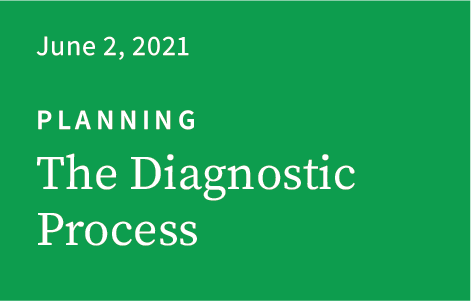Transcript
The Diagnostic Process
When people with memory problems suspect they have Alzheimer’s disease, there are usually four main questions they have for me: Is there something wrong with me? What’s wrong with me? What’s going to happen to me? What can I do about it?
These questions can only be answered by first establishing a diagnosis. Not all memory problems and dementias are Alzheimer’s disease. There’s a long list of health conditions that can affect thinking, some of which are very treatable or even curable. Low thyroid hormone levels, low vitamin B12 levels, and liver or kidney disease can all have effects on the brain. A CT or MRI scan of the brain can reveal small strokes, fluid collections, or tumors that have been growing that are affecting memory and thinking areas of the brain, some of which may be very treatable.
When I meet with a patient for the first time, I follow a classical medical history and physical exam approach. I strongly recommend they bring someone who knows them well to the visit—a spouse or other family member or friend—in case the patient cannot remember important details.
I like to get background information about a person’s health history and life experiences. I want to know the signs or symptoms that made them believe their memory and thinking were off. I then look deeper: Have these symptoms gotten worse over time? How much do they affect day-to-day life? For example, is the patient independently taking care of their business affairs, housework, and self-care, or do they need help or prompting to get things done?
I ask questions to see if the difficulties are confined to memory or whether they affect other related functions, such as language, or organization and decision-making—what we call “executive functioning.” I ask about the patient’s visual or spatial abilities, like navigating space outside or inside the home. Changes in personality, as well as any new physical difficulties such as altered balance and walking, or loss of dexterity or ability to use utensils or tools, can also be indicators of thinking difficulties. I ask about changes in hearing, vision, or smell, which can be linked with cognitive difficulties.
Have they had any other neurological problems like strokes, seizures, or concussions? Have there been any changes in the person’s ability to control their bladder or bowels? Are there any painful conditions? You can imagine that this comprehensive evaluation takes time.
I then like to learn about personal and family health history, especially if their parents, siblings, aunts or uncles had neurological problems, like Alzheimer’s or Parkinson’s disease. It’s important to get a sense of someone’s personal background, whether their childhood was healthy or difficult, how far they went in school, what kinds of work they did, and their current and past habits—especially tobacco, alcohol, or drug use.
The patient’s environment can provide important diagnostic clues. Have there been any toxic exposures through work or hobbies? These factors may affect the risk for developing memory problems later on in life. It’s necessary to know about all medications or supplements, some of which can also affect memory and thinking.
A thorough physical exam is important to determine if the thyroid gland is enlarged, or if heart murmurs or heart rhythm irregularities are present, which might point to a risk for blood clots that cause strokes.
Neurological and cognitive testing are part of this exam. A neurological exam tests muscle strength, sensation, and coordination, all of which can indicate whether there are any focal problems in brain function, Parkinson’s disease, or other neurological conditions that affect memory and thinking in ways similar to Alzheimer’s but would require different treatments.
A formal cognitive screening exam can take as little as five minutes. It’s important to note that people can often have significant memory and thinking difficulties but not be aware of it. The answers to specific questions in cognitive testing can help pinpoint problems in memory, visual-spatial abilities, language, and mental flexibility.
Say someone comes to me with a history of slowly worsening memory and thinking difficulties that at first were hard to distinguish from changes that normally happen in our 60s and 70s. Indeed it’s not always easy to tell. All of us slow down some as we age. We find it harder to do two things at once. We might have more frequent, though generally benign short-term memory hiccups than in the past. You see someone familiar and can’t quite place them, but then it comes back to you. It’s common to have difficulty finding words—especially coming up with names of people or things that are just on the tip of the tongue.
With very rare exception, this is all a universal part of aging. Concerns arise when there’s been a noteworthy decline from the person’s previous ability to think and remember. As I just mentioned, a cognitive screening test might help isolate pathological problems from normal aging. Diagnostically, if we observe a significant change, but the patient’s still getting by in their day-to-day life, albeit more slowly and with greater effort, we call it mild cognitive impairment. But if the impairment is bad enough to cause struggles managing day-to-day affairs, whether it be shopping or paying the bills independently, preparing meals and keeping house, or taking care of their personal hygiene—we call that dementia.
Cognitive impairment and dementia have many causes. We look especially closely for identifiable and treatable causes like other medical conditions, medication side effects, stroke, Parkinson’s, or tumors. If we find no evidence, then the most likely cause is Alzheimer’s disease.
But Alzheimer’s is a hard disease to diagnose with certainty. The only way to be 100 percent sure of the diagnosis is by looking at someone’s brain tissue under a microscope after they die, where we see, as Dr. Alois Alzheimer did over 100 years ago, amyloid plaques and tau tangles. These plaques and tangles are made of specific proteins that we all normally have, but in Alzheimer’s disease, they get processed abnormally, crumple up in and between brain cells, and slowly accumulate over time. This accumulation is strongly associated with the death of brain cells. As these brain cells and the connections between them degenerate, memory and thinking decline.
While I say the only way we can be 100 percent certain of a diagnosis is by sampling brain tissue, it’s important to note that over the past 10 to 15 years there has been tremendous progress in biomarker research. Biomarkers are laboratory or imaging tests that highly correlate with disease pathology in the brain. So, we now have MRI measures that can show patterns of brain degeneration, or PET scans that can reveal the amount of amyloid or tau in the brain. Spinal fluid samples allow us to measure levels of amyloid and tau proteins as well as many other proteins that reflect disease and degeneration in the brain.
With these biomarkers we can now predict with more than 95 percent certainty whether the cognitive difficulties are indeed caused by Alzheimer’s disease. Other very exciting research is now showing promise with ultrasensitive lab tests that detect amyloid and tau proteins that leak out into the bloodstream. These protein levels in blood are very low, but may be enough to determine if there is Alzheimer’s disease in the brain with a reasonable degree of confidence.
It’s important to recognize that more often than not, more than one disease process is at play in causing a person’s cognitive decline and dementia. In addition to Alzheimer’s disease plaques and tangles, it’s very common also to see brain changes such as atherosclerosis of the blood vessels as well as narrowing and stiffening of the small branching vessels feeding the deep parts of the brain.
Back in the old days, dementia used to be called hardening of the arteries in the brain. That’s because atherosclerosis in the brain’s blood vessels was so common. But that was before we were able to prevent atherosclerosis by diagnosing and treating its main causes: high blood pressure, diabetes, and high cholesterol. I think the term is still apt in some people who display vascular disease and mini-strokes. To a lesser degree, small vessel disease frequently contributes or adds to Alzheimer’s dementia in many if not most people. Some people also have Parkinson’s disease pathology along with Alzheimer’s and vascular pathologies. It’s important to be aware that there is likely more than one thing going on. From a treatment standpoint, we need to tailor our approach to treat these other conditions if we think they are contributing to dementia.
When people ask me about my diagnostic approach to the “typical” patient with Alzheimer’s disease, I say I’m still waiting to meet a typical patient. As we’ve seen, there are so many possible factors contributing to memory and thinking problems. For this reason, all of the steps in my evaluation I discussed today are critical to coming up with the diagnosis and recommendations that are right for any individual’s treatment and care.
Steven E. Arnold, MD
Professor of Neurology
Harvard Medical School
Managing Director
Interdisciplinary Brain Center, Massachusetts General Hospital
www.actru.org

